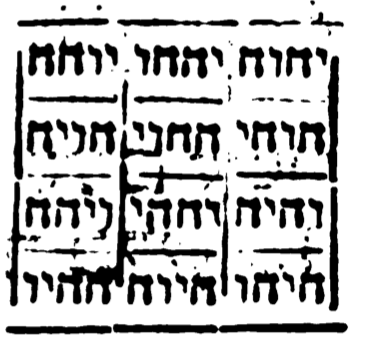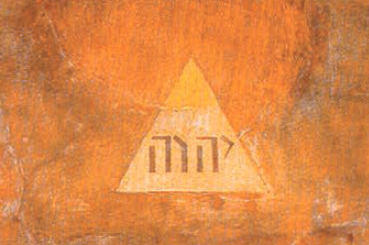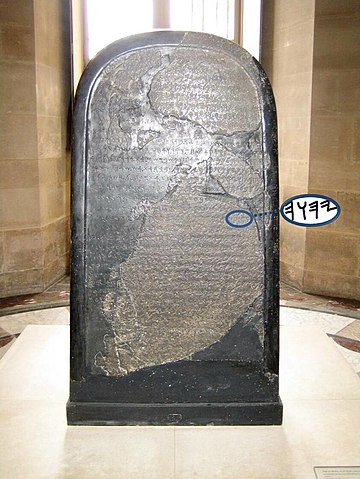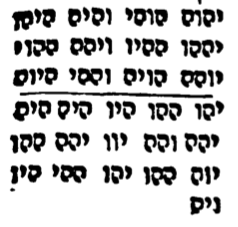Tetragrammaton
The Tetragrammaton (/ˌtɛtrəˈɡræmətɒn/; from Ancient Greek τετραγράμματον tetragrámmaton "[consisting of] four letters"), or Tetragram, is the four-letter Hebrew theonym יהוה (transliterated as YHWH), the name of God in the Hebrew Bible.
The four letters, written and read from right to left (in Hebrew), are yodh, he, waw, and he. The name may be derived from a verb that means "to be," "to exist," "to cause to become," or "to come to pass." While there is no consensus about the structure and etymology of the name, the form Yahweh is now accepted almost universally, though the vocalization Jehovah continues to have wide usage.
The books of the Torah and the rest of the Hebrew Bible except Esther, Ecclesiastes, and (with a possible instance of the short form יה in verse 8:6) the Song of Songs contain this Hebrew name. Observant Jews and those who follow Talmudic Jewish traditions do not pronounce יהוה nor do they read aloud proposed transcription forms such as Yahweh or Yehovah; instead they replace it with a different term, whether in addressing or referring to the God of Israel. Common substitutions in Hebrew are Adonai ("My Lord") or Elohim (literally "gods" but treated as singular when meaning "God") in prayer, or HaShem ("The Name") in everyday speech.
Etymology
The Tetragrammaton is not attested other than among the Israelites, and seems not to have any plausible etymology. The Hebrew Bible explains it by the formula Ehye ašer ehye ("I Am that I Am"), the name of God revealed to Moses in Exodus 3:14.
This would frame Y-H-W-H as a derivation from the Hebrew triconsonantal root היה (h-y-h), "to be, become, come to pass", with a third person masculine y- prefix, equivalent to English "he", thereby affording translations as "he who causes to exist," "he who is," etc.; although this would elicit the form Y-H-Y-H (יהיה), not Y-H-W-H. To rectify this, some scholars proposed that the Tetragrammaton represents a substitution of the medial y for w, an occasionally attested practice in Biblical Hebrew as both letters represented matres lectionis; others proposed that the Tetragrammaton derived instead from the triconsonantal root הוה (h-w-h), "to be, constitute", with the final form eliciting similar translations as those derived from h-y-h.
Modern scholarly consensus, however, considers Ehye ašer ehye to be a folk etymology; a later theological gloss invented at a time when the original meaning of the Tetragrammaton had been forgotten.
Pronunciation
Like all letters in the Hebrew script, the letters in YHWH originally indicated consonants. In unpointed Biblical Hebrew, most vowels are not written, but some are indicated ambiguously, as certain letters came to have a secondary function indicating vowels (similar to the Latin use of I and V to indicate either the consonants /j, w/ or the vowels /i, u/). Hebrew letters used to indicate vowels are known as אִמּוֹת קְרִיאָה (imot kri'a) or matres lectionis ("mothers of reading"). Therefore, it can be difficult to deduce how a word is pronounced from its spelling, and each of the four letters in the Tetragrammaton can individually serve as a mater lectionis.
One of the frequent cases was the Tetragrammaton, which according to later Rabbinite Jewish practices should not be pronounced but read as "Adonai" (אֲדֹנָי/"my Lord"), or, if the previous or next word already was Adonai, as "Elohim" (אֱלֹהִים/"God"). Writing the vowel diacritics of these two words on the consonants YHVH produces יְהֹוָה and יֱהֹוִה respectively, ghost-words that would spell "Yehovah" and "Yehovih" respectively.
The oldest complete or nearly complete manuscripts of the Masoretic Text with Tiberian vocalisation, such as the Aleppo Codex and the Leningrad Codex, both of the 10th or 11th century, mostly write יְהוָה (yhwah), with no pointing on the first h. It could be because the o diacritic point plays no useful role in distinguishing between Adonai and Elohim and so is redundant, or it could point to the qere being שְׁמָא (šəmâ), which is Aramaic for "the Name."
YHVH as "Jehovah"
The scholarly consensus is that the original pronunciation of the Tetragrammaton was "Yahweh" (יַהְוֶה). Non-Jews later combined the vowels of Adonai with the consonants of the Tetragrammaton and invented the name "Jehovah." The adoption at the time of the Protestant Reformation of "Jehovah" in place of the traditional "Lord" in some new translations, vernacular or Latin, of the biblical Tetragrammaton stirred up dispute about its correctness.
In 1711, Adriaan Reland published a book containing the text of 17th-century writings, five attacking and five defending it. The opponents of "Jehovah" said that the Tetragrammaton should be pronounced as "Adonai" and in general do not speculate on what may have been the original pronunciation, although mention is made of the fact that some held that Jahve was that pronunciation.
Almost two centuries after the 17th-century works reprinted by Reland, 19th-century Wilhelm Gesenius reported in his Thesaurus Philologicus on the main reasoning of those who argued either for יַהְוֹה/Yah[w]oh or יַהְוֶה/Yahweh as the original pronunciation of the Tetragrammaton, as opposed to יְהֹוָה/Yehovah, citing explicitly as supporters of יְהֹוָה the 17th-century writers mentioned by Reland and implicitly Johann David Michaelis (1717–1791) and Johann Friedrich von Meyer (1772–1849), the latter of whom Johann Heinrich Kurtz described as the last of those "who have maintained with great pertinacity that יְהֹוָה was the correct and original pointing." Edward Robinson's translation of a work by Gesenius, gives Gesenius' personal view as: "My own view coincides with that of those who regard this name as anciently pronounced [יַהְוֶה/Yahweh] like the Samaritans."
Use outside the Bible
The Mesha Stele contains the oldest known inscription of the Tetragrammaton dates to 840 BCE. The text on the stele was written in a variant of the Phoenician alphabet, closely related to the Paleo-Hebrew script. It also has the most extensive inscription ever recovered that refers to the kingdom of Israel (the "House of Omri") and bears the earliest certain extrabiblical reference to the Israelite god Yahweh. It is also one of four known contemporary inscriptions containing the name of Israel, the others being the Merneptah Stele, the Tel Dan Stele, and one of the Kurkh Monoliths.
However, the authenticity of the Mesha Stele has been disputed over the years, and some biblical minimalists suggest the text was not historical, but a biblical allegory. The stele itself is regarded as genuine and historical by the vast majority of biblical archaeologists today.
Ancient Egypt
An Egyptian hieroglyphic inscription of the Pharaoh Amenhotep III (1402–1363 BCE) mentions a group of Shasu whom it calls "the Shasu of Yhw" (read as: ja-h-wi or ja-h-wa). James D. G. Dunn and John W. Rogerson tentatively suggest that the Amenhotep III inscription may indicate that worship of Yahweh originated in an area to the southeast of Palestine.
A later inscription from the time of Ramesses II (1279–1213 BCE) in West Amara associates the Shasu nomads with S-rr, interpreted as Mount Seir, spoken of in some texts as where Yahweh comes from. Frank Moore Cross says: "It must be emphasized that the Amorite verbal form is of interest only in attempting to reconstruct the proto-Hebrew or South Canaanite verbal form used in the name Yahweh. We should argue vigorously against attempts to take Amorite yuhwi and yahu as divine epithets." Thomas Schneider argued for the existence of a theophoric name in a Book of the Dead papyrus dating to the late 18th or early 19th dynasty which he translated as ‘adōnī-rō‘ē-yāh, meaning “My lord is the shepherd of Yah."
Magical papyri
Among the Jews in the Second Temple Period, magical amulets became very popular. Representations of the Tetragrammaton name or combinations inspired by it in languages such as Greek and Coptic, giving some indication of its pronunciation, occur as names of powerful agents in Jewish magical papyri found in Egypt. Iαβε Iave and Iαβα Yaba occurs frequently, "apparently the Samaritan enunciation of the tetragrammaton YHWH (Yahweh)."
The most commonly invoked god is Ιαω (Iaō), another vocalization of the tetragrammaton YHWH. There is a single instance of the heptagram ιαωουηε (iaōouēe).
The Vulgate
The Vulgate, the Latin translation of the Bible made from the Hebrew in the 4th century CE, uses the word Dominus ("Lord"), a translation of the Hebrew word Adonai, for the Tetragrammaton.
The Vulgate translation, though made not from the Septuagint but from the Hebrew text, did not depart from the practice used in the Septuagint. Thus, for most of its history, Christianity's translations of the Scriptures have used equivalents of Adonai to represent the Tetragrammaton. Only at about the beginning of the 16th century did Christian translations of the Bible appear combining the vowels of Adonai with the four (consonantal) letters of the Tetragrammaton.
Spoken prohibitions
The vehemence with which the utterance of the name is denounced in the Mishnah suggests that use of the name Yahweh was unacceptable in rabbinical Judaism. "He who pronounces the Name with its own letters has no part in the world to come!" Such is the prohibition of pronouncing the Name as written that it is sometimes called the "Ineffable," "Unutterable," or "Distinctive Name," or "Explicit Name" ("Shem HaMephorash" in Hebrew).
Halakha prescribes that although the Name is written יהוה "yodh he waw he'" if not preceded by "my Lord" (אֲדֹנָי, Adonai) then it is only to be pronounced "Adonai" and if preceded by "Adonai" then it is only to be pronounced as "Our God" (אֱלֹהֵינוּ, Eloheinu), or, in rare cases, as a repetition of Adonai. Thus when someone wants to refer in third person to either the written or spoken Name, the term HaShem "the Name" is used; and this handle itself can also be used in prayer.
The Masoretes added vowel points (niqqud) and cantillation marks to the manuscripts to indicate vowel usage and for use in ritual chanting of readings from the Bible in Jewish prayer in synagogues. To יהוה they added the vowels for "Adonai" ("My Lord"), the word to use when the text was read. While "HaShem" is the most common way to reference "the Name", the terms "HaMaqom" (lit. "The Place", i.e. "The Omnipresent") and "Raḥmana" (Aramaic, "Merciful") are used in the mishna and gemara, still used in the phrases "HaMaqom y'naḥem ethḥem" ("may The Omnipresent console you"), the traditional phrase used in sitting Shiva and "Raḥmana l'tzlan" ("may the Merciful save us" i.e. "God forbid").
The Kabbalah
Kabbalistic tradition holds that the correct pronunciation is known to a select few people in each generation, it is not generally known what this pronunciation is. There are two main schools of Kabbalah arising in 13th century Spain: Theosophic Kabbalah represented by Rabbi Moshe De Leon and the Zohar and the Kabbalah of Names or Prophetic Kabbalah whose main representative is Rabbi Abraham Abulafia of Saragossa.
Rabbi Abulafia wrote many wisdom books and prophetic books where the name is used for meditation purposes from 1271 onwards. Abulafia put a lot of attention on Exodus 15 and the Songs of Moses. In this song it says "Yehovah is a Man of War, Yehovah is his name." For Abulafia the goal of prophecy was for a man to come to the level of prophecy and be called "Yehovah a man of war." Abulafia also used the tetragrammaton in a spiritual war against his spiritual enemies. For example, he prophesied in his book "The Sign," "Therefore, thus said YHWH, the God of Israel: Have no fear of the enemy."
The Tetragrammaton is used in many rituals of Solomonic magic.
The letters YUD and HEI (יה) are effective at fighting against the power of the qlippoth.
Permutations of YHVH
Most of the older texts dealing with the Archangels of the Zodiac (or other occult books explaining the 12 signs of the zodiac) attempt to assign a permutation of the Tetragrammaton to each of the archangels and to the zodiac signs themselves. However, there are significant discrepancies between the various texts, and some texts have blatant errors in the Hebrew characters, making the question of which is correct difficult to answer with any authority. Agrippa's Three Books of Occult Philosophy contains significant deviations, and an error.
The Tikunei Zohar, likely the oldest text giving the permutations of YHVH, contains an order that is different from most other sources. It is a separate book from the original (and older) Zohar, although the two books are considered related texts.
Although the Sefer HaBahir describes the permutations of YHVH, it does not explicitly list them.
Modern Jewish scholars use the order: YHVH, YHHV, YVHH, HVHY, HVYH, HHVY, VHYH, VHHY, VYHH, HYHV, HYVH, HHYV. This is the same order utilized by magicians in the Hermetic Order of the Golden Dawn. Grimoires listing the permutations are outlined below and deviations from the expected standard are in bold.
- De Arte Cabbalistica (1517): YHVH, YHHV, YVHH, HVHY, HVYH, HHYV, VHYH, VYHH, VHHY, HYHV, HYVH, HHVY.
- Three Books of Occult Philosophy (1531): YHVH, YHHV, YVHH, HVHY, HVYH, HHYV, VHHY, YVHH, VHYH, HYHV, HYVH, HHVY.
- Tikunei Zohar (1558): YHVH, YHHV, YVHH, HVHY, HHYV, HVYH, VHYH, VYHH, VHHY, HYHV, HHVY, HYVH.
- Oedipus Aegyptiacus (1652): YHVH, HVHY, VHYH, HYHV, YHHV, HHVY, VHHY, HYVH, YVHH, HVYH, VYHH, HHYV.
Several grimoires published after 1700 utilize the order from Three Books of Occult Philosophy, including the erroneous second YVHH.



